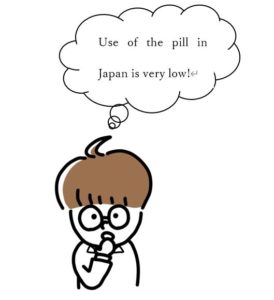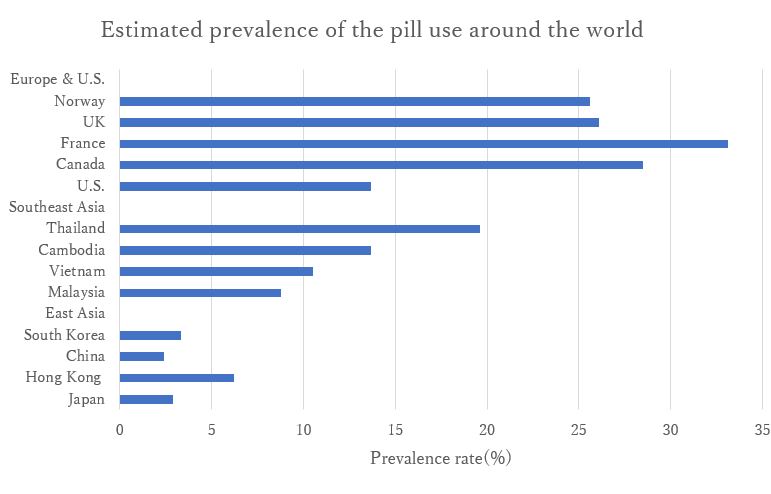02 Feb Chapter2: The lifesaver for period! The low-dose pill. 生理の救世主!低用量ピル
The original content is here ⇒日本語
Isn’t the pill for birth control?
It can also make periods lighter and control cycles.
Have you ever heard of the “low-dose pill”? You may have seen it described as an “oral contraceptive” in your health and physical education textbooks. The pill is one of the most important contraceptive options for women. (→ For more information on contraception using the pill, see chapter 4)
However, the effects of the pill go beyond that. It can suppress ovulation and reduce the proliferation of the endometrium, thus making periods lighter. Specifically, it can reduce the amount of menstrual blood and relieve premenstrual symptoms such as irritability, mood swings, and skin problems (premenstrual syndrome: PMS(The link is to MedlinePlus.gov.)). It can also regulate and stabilize the menstrual cycle.
Medications that have the same active ingredients as the pill and are prescribed to treat dysmenorrhea and endometriosis are called LEP and are covered by insurance. (These Links are to MedlinePlus.gov.) 
|
If you take an oral contraceptive pill, you can know the exact day your period will begin and can even change the date at will. This can also reduce the frequency of your periods, allowing you to stagger them so they don’t coincide with important trips, exams, and competitions!
|
Resting your uterus and ovary could reduce the risks of various disorders.
While you are on the pill, your ovulation stops. This allows the ovaries to rest and reduce the proliferation of the endometrium. In other words, it allows the uterus to “rest”.
This reduces the risk of developing ovarian or uterine cancer.
You may be thinking, “Isn’t it unnatural and bad for my health to stop ovulation?”
However, ovulation and menstruation stop during pregnancy. Since women today have fewer pregnancies, they ovulate and menstruate more often in their lifetime than in the past. In other words, people today put more stress on their uterus and ovaries than before.
Having a more frequent menstrual cycle could be rather unnatural in a way.
What are the side effects of the pills?
The most concerning side effect with the pills is thrombosis.
Many women experience nausea, headaches, and irregular bleeding when they first take birth control pills. These symptoms disappear as they continue taking the pills.
The side effect of birth control pills that is most concerning is thrombosis.
Number of women who develop thrombosis a year (U.S. Food and Drug Administration [FDA], 2012)
| Taking birth control pills | 3-9 persons |
| Not taking birth control pills | 1-5 persons |
| during pregnancy | 5-20 persons |
|
12 weeks after delivery |
40-65 persons
|
* This data also allows us to assume that the pills prevent having pregnancies with a high risk of thrombosis.
(Smokers may not be able to take the pill.)
Use the acronym ACHES to remember the symptoms of thrombosis!
If you experience any of the following symptoms while taking the pill, see your OB/GYN immediately. If you see an internist or orthopedic surgeon, be sure to inform the doctor that you are taking the pill.
A: abdominal pain (severe abdominal pain)
C: chest pain (severe chest pain, difficulty breathing, crushing pain)
H: headache (severe headache)
E: eye / speech problems (abnormal vision, slurred vision, convulsions, disorientation)
S: severe leg pain (calf pain/swelling, pain when gripping, redness)
【Column】
Estimated prevalence of birth control pill use around the world
Europe and the U.S.
Norway 25.6%, UK 26.1%, France 33.1%, Canada 28.5%, U.S. 13.7%
Southeast Asia
Thailand 19.6%, Cambodia 13.7%, Vietnam 10.5%, Malaysia 8.8%
East Asia
South Korea 3.3%, China 2.4% (Hong Kong 6.2%), Japan 2.9%
Contraceptive Use by Method 2019
|
Use of the pill in Japan is very low! |

Ask your OB-GYN doctor
 Can I ask my doctor for a prescription for the pill?
Can I ask my doctor for a prescription for the pill?
Of course. Please feel free to do so.
The pill is an oral contraceptive (OC) and it’s also used as a medicine for treating dysmenorrhea.
LEP has the same components as an OC and can be covered by health insurance.
LEP is also effective in treating premenstrual syndrome (PMS). (→Refer to chapter 4.)
Consult your obstetrician/gynecologist about contraception, dysmenorrhea, and PMS.
 Does taking the pill affect my fertility/ability to have children?
Does taking the pill affect my fertility/ability to have children?
No. Taking the pill does not affect your ability to conceive.
In fact, it can be used to prevent infertility.
Long-term use of the pill has been shown to have no effect on fertility. Once you stop taking the pill, menstruation will resume within 1-3 months and pregnancy will be possible. If menstruation does not resume or pregnancy does not occur, causes other than the pill are highly possible, so you should consult an obstetrician/gynecologist.
Endometriosis is gaining attention as a cause of infertility. The pill is thought to reduce the onset and progression of endometriosis, and women who take the pill are expected to decrease in infertility.
One Student’s Experience
How I got started on the pill
My periods were so heavy that I had to use a nighttime sanitary pad even during the day. When I sat in class, I would sometimes get blood on my pants…. On the recommendation of a friend, I visited an obstetrician/gynecologist, who diagnosed me with dysmenorrhea and prescribed a contraceptive drug called low estrogen progesterone(LEP). Since I started taking it, my periods have been lighter and I’ve been able to get away with using daytime sanitary pads!
How I manage not to forget to take the medication
Dysmenorrhea was resolved with the drug LEP. The only problem was that I often forgot to take it, so what I did was to keep the pills at my bedside and take them before bed. By putting them where I could always see them, I never forgot to take them. Some of my friends take them with their breakfast. I hope you could find a way that suits you!
Column
Types of the Pill
There are high-dose, medium-dose, low-dose, and ultra-low-dose pills, depending on the amount of hormones in the pill. The two most commonly-used types these days are the low-dose pill and the ultra-low-dose pill. Most women find either to be effective enough but, in rare cases, one is more effective than the other. All of the pills also allow women to control the onset of menstruation and reduce the frequency of menstruation. As for LEP, specifically YazFlex combination tablets or JEMINA® tablets, which are covered by health insurance, they are approved for long-term continuous use, and you can hopefully reduce menstrual bleeding to three to four times a year.
Note from SEMI Oral contraceptives (OC) and Low Estrogen Progestin Combinations (LEP) have almost the same ingredients. Both contain the same active ingredients, Estradiol and Progestin.
In Japan, contraceptives are not covered by insurance because contraception is not a disease. However, under the insurance system, LEPs prescribed to treat dysmenorrhea and other symptoms do not fall into the birth control pill category and are therefore covered by insurance.
Refer to ”Use of OC and LEP”


